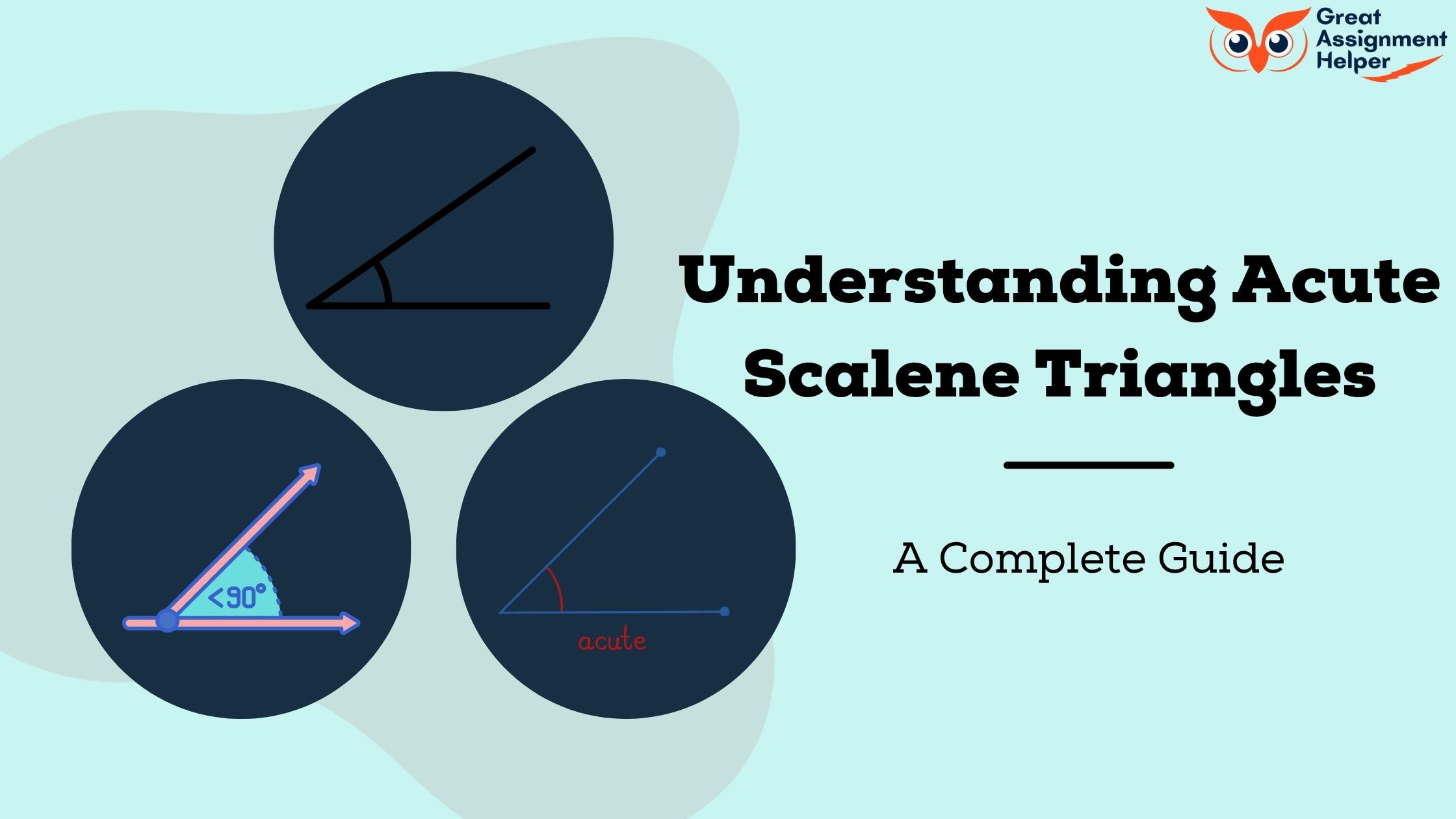
Triangles are fundamental shapes in geometry, and among them, the acute scalene triangle—one with three unequal sides and all angles less than 90°—is particularly rich in properties and applications. The Greatassignmenthelper article “Comprehensive Guide to Acute Scalene Triangles” defines it succinctly: “An acute triangle consists of three acute angles (measuring less than 90 degrees), while scalene triangles contain three unequal sides and angles” . But there’s much more to explore. In this guide, we’ll:
- Recap the essentials
- Explore unique properties
- Walk through detailed examples
- Connect geometry to the real world
- Offer practice problems, tips, and educational tools
Listen To This Blog
What Is an Acute Scalene Triangle?
- Acute: All angles are strictly less than 90°.
- Scalene: All three sides are of different lengths, so all angles are also distinct.
Put together, an acute scalene triangle has three distinct sides, three distinct acute angles, and no side is perpendicular to another.
Why It Matters
Studing one subcategory (acute + scalene) enables deeper insight. Many theorems about altitudes, centers, and trigonometric rules are most elegant when no special symmetry (like isosceles or right angle) is assumed.
Key Theoretical Properties
A. Angle-Side Relationships
By definition, each angle μ satisfies:
0° < A, B, C < 90°, and A + B + C = 180°.
For sides a, b, c, the law of cosines implies: a² + b² > c², b² + c² > a², c² + a² > b², just as in standard acute triangles.
B. Centers Located Inside
In an acute triangle:
- Orthocenter (intersection of altitudes) lies inside.
- Circumcenter (intersection of perpendicular bisectors) is also inside.
This contrasts with obtuse triangles, where one or both may fall outside.
C. Altitudes and Medians
All altitudes fall within the triangle’s interior. Medians satisfy inequalities like:
4c² + 9a²b² > 16ma²mb², where c is the longest side and ma, mb are medians to the other sides.
Worked Examples
Example 1: Basic Trigonometry
Given sides a = 7, b = 8, c = 9. Show it’s acute scalene.
Check acute:
7² + 8² = 113 > 9² = 81
8² + 9² = 145 > 7² = 49
9² + 7² = 130 > 8² = 64
All angles < 90°
Using Law of Cosines:
cosA = (b² + c² - a²) / (2bc) = (64 + 81 - 49) / (2×8×9) = 96 / 144 = 2/3 → A ≈ 48.2°
cosB = (49 + 81 - 64) / (2×7×9) ≈ 0.5238 → B ≈ 58.5°
cosC = (49 + 64 - 81) / (2×7×8) ≈ 0.2857 → C ≈ 73.4°
All angles are distinct and acute, confirming it’s an acute scalene triangle.
Example 2: Centers
Circumradius R via extended law:
R = (abc) / (4 × Area)
Use Heron’s formula to find area, then calculate R.
Real‑World Applications
- Architecture & Engineering: Roof trusses use acute scalene triangles for stress distribution.
- Geodesy & Surveying: Triangulation maximizes accuracy using irregular triangles.
- 3D Capture: Three sensors form a scalene acute triangle for blind-spot-free imaging.
Additional Concepts
I. Interiors and Inequality Proofs
Median inequalities ensure altitudes and bisectors behave predictably inside acute triangles.
II. Euler Line
In acute scalene triangles, the Euler line (joining centroid, orthocenter, circumcenter) lies entirely within the triangle.
III. Nine‑Point Circle
This circle passes through midpoints and feet of altitudes. It remains fully inside in acute scalene triangles.
Study Tips & Practice Problems
Always apply the law of cosines first to verify if a triangle is acute. Use law of sines or area-angle methods for further analysis.
Practice Problem:
- Sides: 6 cm, 7 cm, 10 cm
- Check if triangle is acute scalene
- Find angle opposite 10 cm
- Calculate area
- Determine circumradius R
- Discuss orthocenter location
Solution: 6² + 7² = 85 < 10² = 100 → Not acute, it’s obtuse!
Understanding this check helps avoid time-consuming errors.
Frequently Asked Questions (FAQ)
Q1: Can one angle be exactly 60° and still be scalene?
A: Yes, if the other two angles are distinct and all sides differ.
Q2: Do altitudes in an acute triangle always cross inside?
A: Yes—this distinguishes acute triangles from obtuse ones.
Q3: Can a scalene triangle be right or obtuse?
A: Yes, but it wouldn’t be an acute scalene triangle anymore.
8. Interactive Tools & Visualizations
Use GeoGebra or Desmos to explore triangle dynamics. Adjust side lengths and watch how centers shift. These tools help visualize abstract math.
9. Structuring Assignments & How to Write Up
Assignment Outline
- Define Terms: acute, scalene
- Verify with Law of Cosines
- Calculate angles
- Compute area and circumradius
- Locate centers: centroid, circumcenter, orthocenter, nine-point circle
- Discuss altitudes and medians
- Reflect on real-world use
Writing Tips
- Introduce triangle concepts using real-world examples
- Show all steps of calculation clearly
- Use labeled diagrams
- Highlight key points visually
10. Summary & Why It Matters
Acute scalene triangles aren't just textbook examples—they're critical in architecture, design, and engineering. From altitude behavior to precise triangulation, these shapes combine theory and utility. By learning their properties, students develop strong spatial and analytical skills.
Final Thoughts
This expanded guide builds on Greatassignmenthelper insights to deliver in-depth learning and assignment help. Embedding interactive tools and practical problems on GreatAssignmentHelper.com makes geometry more engaging and educational.
Learn the basics of square pyramids, including their structure, formulas for surface area and volume, and real-world applications in geometry.

